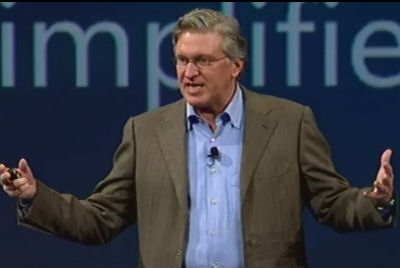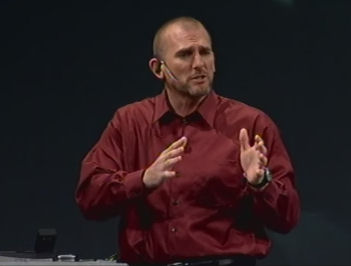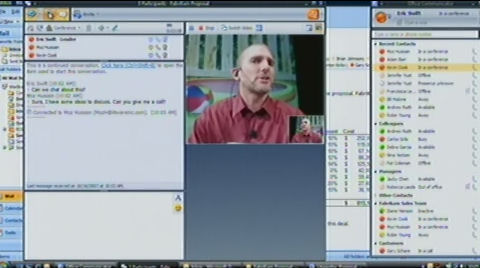Gates Promises 'Magic' Transformation of Telecommunications Through UC
"The milestone that we're at," announced Microsoft Chairman Bill Gates at his company's campus this morning, "is that we're finally bringing to this idea of trying to get in contact with somebody, knowing what number to call, knowing how to connect many people together, knowing when they're available...the magic of software." With those words, Gates officially launched his company's Unified Communications platform, which will include a new class of telecommunications server product whose objective is to replace the office PBX.
"In fact, this is a complete transformation of the business of the traditional PBX," Gates continued. "The PBX in some ways is almost like the mainframe was many years ago, where all of the functionality was there in that one piece. And the way that you add flexibility, add value, to customize, to bring in third parties, to do new things, it just isn't there in that structure. So by moving phone calls onto the Internet using the powerful industry standard servers, we've got a very different way of being able to do things. And that can lead not only to lower costs, but far more effectiveness in how your employees work within your company, or with customers and partners outside your company."
From the perspective of a communications engineer, Microsoft's UC platform is an attempt to crash head-first into an entrenched market, where the existing players are all huge and, in many extents, are at Microsoft's level.
But from the perspective of an IT professional, who's more intimately familiar with software - and who may be more familiar with Windows and Office than anyone might rightfully want to be - the UC move is a way to evolve Microsoft's own entrenched market, which includes the ubiquitous Outlook, lest a lack of development and innovation allows that market to languish at just the time it may start to see competition once again.
For nearly the first 40 minutes of this morning's launch presentation, neither audience members nor webcast viewers actually saw the products being delivered, although occasionally their brands were flashed onto the wall monitor. Office Communications Server 2007 will be at the heart of UC, as the key software driving Microsoft's replacement for the PBX. This software enables an otherwise common server cluster to handle voice communications, instant messaging, voice mail, and point-of-presence.
The Outlook user sees all of this from one window, which now in addition to e-mail and calendaring serves as the nerve center for direct communication, store-and-forward voice messaging, and remote meeting facilitation as well.
Office Communicator 2007 serves as the company's all-in-one messaging client, merging the texting and video capabilities of something on the order of Skype with the features of a full-scale business telephone. But let's not kid ourselves: OC is a feature of Outlook, and the two are designed to be well integrated with one another. And while Live Meeting is designed to function as a company's remote videoconferencing service, the capability to invite contacts, retrieve scheduling information from communications, and embed documents in messages sent to participants is obviously woven into Outlook.
And Outlook is Office, and Office is one of Microsoft's pillars of long-term revenue.
 |
"I no longer blind-call at work," proclaimed Microsoft Business Division President Jeff Raikes this morning. "I simply check the presence of the person I'm trying to reach. Our research indicates that the average information worker spends 37 minutes per week in 'voice mail jail' or playing phone tag, and that adds up to more than 30 hours of productivity per year. But by using identity and presence at the core [OCS], you recapture that time."
 |
That time is clearly recaptured through Outlook, as Unified Communications Group senior director Eric Swift demonstrated.
After repeating a demo many had seen before where Outlook Voice Access responds (or tries to respond) to his voice commands over a cell phone connection, Swift showed pictures of how the same capabilities to check contacts' presence and availability, to place phone calls in response to e-mails without checking the number, and to manage instant messages and document transfers between people in a phone call as the call is taking place, can be made portable to a new version of Outlook Mobile. Notice it's not being called "Office Communicator Mobile."
 |
Those same capabilities can then be transferred to the Outlook client on a user's notebook computer, which Swift demonstrated as though it were set up in front of his own backyard barbecue. There was no unusual hardware in this setup, just an ordinary Webcam attached to the top of his lid. "Without even requiring a VPN, I have all of my communications capabilities right here with me," Swift said, "connected over the Internet, right from my backyard...Now in this case, I'm looking at Outlook, where a lot of us spend our time..."
The rest of that segment of the demo springs forth from information that was embedded in an e-mail visible from Outlook.
It was a reasonably convincing demonstration of a businessman using UC in an everyday scenario. It could perhaps have been made more compelling had the participants - likely other Microsoft employees posing as actors - had less obviously been stationed in an adjoining room.
Next: Searching for the 'proposition' part of UC's 'value proposition'...
|
| Microsoft's Eric Swift demonstrates a video conference that was precipitated by an Outlook e-mail message. Along the right side is Microsoft's Office Communicator (OC)client, which contains the active contact list and which register's each contact's relative presence. In the middle is the conferencing window, which was launched through OC. However, it's still linked to Outlook because future e-mail senders can be invited in the same way OC clients can be invited in: through a drag-and-drop process. |
